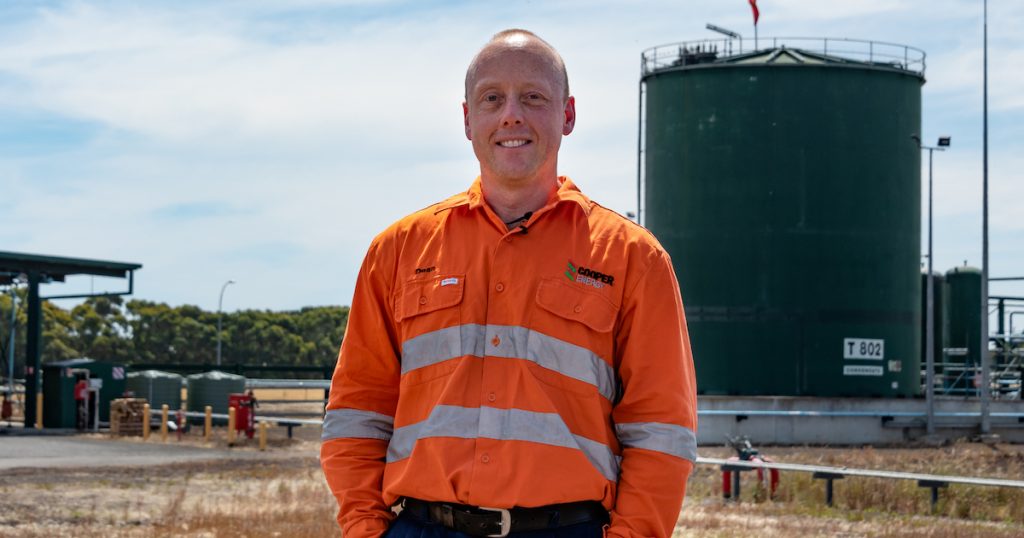“Gas is everywhere”
When we next turn on our kitchen gas cooktops and they alight, perhaps we should all whisper a little thank you to people like Dean Johnson.
If you live in South Australia, chances are the 43-year-old dad from Beaumont, in Adelaide’s eastern suburbs, will be at the other end of the gas pipeline ensuring you get what you need.

43 year old South Australian dad, Dean Johnson
“I don’t think people really have an appreciation or idea of the breadth of how gas touches their lives,” the Cooper Energy operations manager said.
“All of our gas goes into pipeline gas so when you turn your barbecue on or your kitchen cooktop you are enjoying the fruits of our work.”
The workers who produce those fruits across Australia have been found to be an intrinsic part of the nation’s way of life.
One might often think of as a gas worker as being stationed off the coast of Western Australia – the technician or rig maintenance worker. Of course, they are there, playing their part.
But what’s often overlooked is that the gas industry supply chain reaches into, and wraps itself around, the suburbs of our smallest, remote towns and biggest cities.
These workers sell gas bottles for home barbecues and businesses, ensure the safety of supply to homes, or work as gas fitters renovating homes or installing deep fryers in fish and chip shops.
Gas is everywhere, the Australian Gas Industry Trust study found, making and powering the products we use – and supporting the employment of over a quarter of million Australians.
Highlighting the depth and scale of the gas industry supply chain’s economic and social contribution, just over 165,000 full time equivalent (FTE) jobs were directly supported as well as about 47,000 businesses.
Western Australia had the most direct jobs at almost 69,000 FTE roles, followed by Queensland at over 31,000, Victoria at almost 29,000, NSW with about 14,000 and NT and SA with about 11,000 jobs each.
Another 95,000 jobs nationally are indirectly supported by the supply chain – meaning a total of just over 260,000 jobs across Australia are directly and indirectly are supported in total.
The study, Economic and Employment Contribution of the Australian Gas Industry Supply Chain: 2020-21, was prepared by Australian Economic Advocacy Solutions for the Australian Gas Industry Trust (AGIT).
The study also reveals how youths are supported with a pathway to employment, with about 2,200 young Australians in apprenticeships and traineeships last financial year.
The gas industry’s supply chain directly provides 1.8 in every 100 jobs nationally – with the NT leading at 11.4 jobs per 100 jobs followed by WA at 7.3 per 100 positions.
AEAS said in its report: “The key finding of this report is that the gas industry supply chain is crucially important to Australia – creating employment opportunities and driving activity.
“In regional areas, the gas industry acts as a foundation for prosperity across many townships due to supply chain spend and the livelihood provided to employees and their spend that this delivers to local businesses.”
The study found the industry generates $55 billion in direct economic activity and pours $18.2 billion into federal, state and local government coffers in taxes, rates, fees and royalties annually.
One in every 54 Australian workers relies on gas for their income, earning an average annual salary of $90,200, compared to the national average wage of $67,902.
The study was welcomed by AGIT, which said it demonstrated how deep the industry was involved in the community.
AGIT Executive Officer Dr Jen Thompson said: “We are everywhere – across our regions and across our suburbs – and all Australians benefit in some way from gas and the supply chain.
“This shows the gas supply chain is intrinsically part of our communities and one of Australia’s biggest drivers of employment and economic activity.
“Three cents in every dollar of economic activity in Australia can be linked to the supply chain, which is enabling $470 billion in economic activity in Australia every year as an essential energy source.”
Explorewith Natural Gas Subscribe


